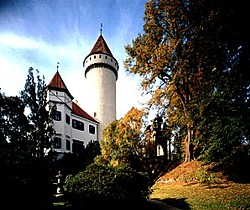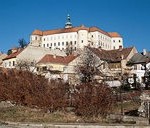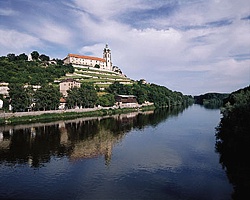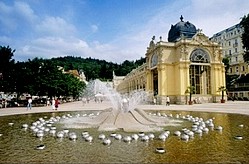Czech Republic
General Information
| Full country name: | Czech Republic |
| Area: | 78,866 sq km |
| Population: | 10.3 million |
| Capital City: | Prague (pop 1.2 million) |
| People: | Czech with minorities of Slovaks, Poles, Germans, Romanies and Hungarians |
| Language: | Czechs |
| Religion: | 40% Roman Catholic, 10% Protestant |
| Government: | Parliamentary democracy |
| Head of State: | President Vaclav Klaus |
| Head of Government: | Prime Minister Jiri Paroubek |
| GDP: | US$69.9 billion |
| GDP per capita: | US$15,800 |
| Annual Growth: | 1.5% |
| Inflation: | 0.6% |
| Major Industries: | Machinery, transport, steel, armaments, vehicles, cement, ceramics, beer, cotton |
| Major Trading Partners: | Germany, Austria, Slovakia, Russia, Italy |
| Member of EU: | Yes |
Beautiful heart of Europe
Those who would like to get acquainted with one of the most beautiful countries in Europe should not miss the Czech Republic - an attractive country situated in the very heart of Europe. The main advantage of the Czech Republic is the wealth, diversity and accessibility of cultural, historical and natural places of interest, all concentrated in a relatively small place that boasts high quality accommodation and dining facilities.
General Information
The Czech Republic lies in the heart of Europe. Intellectual and cultural currents from West and East have met here since time immemorial. It has been the site of frequent clashes of the political and economic interests of leading European empires throughout the years This in turn has given origin to a unique culture enriched with the influence of its neighbouring states.
The Czech Republic is a stable democratic country. The fall of the communist regime and the restoration of democracy in 1989 led to the resumption and strengthening of traditional relationships which had been interrupted during this period. We are a parliament democracy with a pluralist political system. Candidate parties compete in free elections every 4 years. The head of state is the president of the republic and is elected for a 5-year period. Václav Klaus is the current president of the Czech Republic.
After 1989 democratic governments started to re-build a normal market economy.
State-owned companies were privatised, shares floated and the Czech crown became convertible currency, the market was opened to all competitors, Czech goods penetrated highly-developed markets and conditions for foreign investment were established.
During this time the Czech Republic has altered dramatically. The living standard and GDP has increased considerably. In 1999 the CR entered NATO and it is now a leading contender for EU membership. Thanks to the new political environment, the number of foreign visitors to the Czech Republic has increased dramatically in recent years, many of which return after their first visit in order to explore all of the beauties it has to offer. Here you will find a large number of cultural, historical and natural places of interest within a relatively small area. Prague has become one of the most visited cities in the world. Bohemia and Moravia offer, a wonderful array of sights and places of historical and natural importance, with excellent standards of accommodation and cuisine. The CR has excellent road and railway connections with neighbouring countries. In Prague there is an international airport.
(For more detailed information see special chapter Transport)
Interesting Places
Karlštejn - Gothic castle built 650 years ago on a picturesque site in the heart of deep forests. The castle was built by Emperor Charles IV as the treasury for safeguarding of the coronation jewels and holy relics. The Imperial Palace contains an exhibition of Charles' life and dynasty; a tapestry version of the Luxembourg family tree can be seen in the Luxembourg Hall.

Konopiště - one of the most beautiful chateaux in Bohemia, situated about 50 km south of Prague. The original castle was built in the late 13th century in the style of a French fortress. It was later also the home of the successor to the Austrian throne, Ferdinand d'Este, whose assassination in Sarajevo sparked off World War I. At present the chateau offers a fine display of historical weapons, hunting trophies furniture, china and Late Gothic sculptures and paintings. A beautiful English park surrounds the Chateau.



The Hluboká chateau is located above a valley formed by the Vltava river at the heart of South-Bohemia. In the 13th century a Gothic castle stood here as a local support to the kingly power which spread over the South of the realm. Later in the 16th century it was later changed into a comfortable aristocratic seat. The Schwarzenberg family rebuilt the place in a Baroque style and a huge Romantic refurbishement action took place between 1841 and 1871, copying the style of English Windsdor Gothic. The whole chateau comprises about 140 rooms, out of which several are available for public tours. The surrounding area has always functioned as an ever-changing landscape serving the purposes of people. The beautiful alleys of ancient trees, pheasantries, carriage ways, vast game parks and a green park of exceptional value all add to the charm of this spot. Lovers of horse and carriage rides, hiking, biking, tenis, golf, ball games, water sports, angling as well as of hunting will surely find this to be a paradise on Earth. In the village Hluboká nad Vltavou one will find several restaurants and bed-and-breakfasts which provide quality services and typical regional cuisine of fish and veal.
Český Krumlov is positioned in the southernmost region of the country. The Vltava river meandering through the town creates obscure shapes and corners over which a number of bridges and crossings stretches. On a relatively confined space around 300 historical buildings, secular as well as religious ones, have been preserved. Undoubtedly, the most popular is the local castle complex which within itself documents some 500 hundred years of architectural development. Many of the buildings due to their exclusive luxurious premises hosts different cultural events. The castle also offers a rarity on central-European scale - a theatre equipped with a revolving auditorium. Among other tourist attractions there is a former municipal brewery which was turned into an exbition centre named after Egon Schiele. The centre focuses on a large number of international artists´ work and is open 365 days a year. In 1963 the town was officially recognized as a historical municipal reserve area and in 1992 it was entered on to the UNESCO World Cultural Heritage List.
Karlovy Vary is located in western Bohemia, in a forested green valley divided by Teplá river. It is the largest spa-town in the country and was established by the Czech king and Roman Emperor Charles IV. in 1358. Among its dominant features there are 12 collonades which serve as a popular leisure destination for tourists as well as spa clients. These springs with temperatures ranging from 42°C to 73°C combined with other natural treatment elements (such as natural gas or peat) are used as the main healing agents. You will be impressed by a cableway trip to Kamzík viewpoint overlooking the town from where all the town´s beauties are easy to observe. People from more than 80 countries of the world visit the town on a regular basis. The town, apart from its romantic architectural monuments, art galleries and colonnades, offers many opportunities for sport lovers. Ardent cinema goers will be pleased to hear that Karlovy Vary film festival has been regularly scheduled here since 1946, becoming thus one of the most significant film festivals in Central as well as Eastern Europe. The town won its praise for other well-known products like china, the Moser glass products, characteristic souvenirs, typical waffles, Mattoni mineral water and Becherovka liquor, frequently called the 13th spring of Karlovy Vary.
Kroměříž - the town originated and was developed in a flat area around the Morava river. Initially, a settlement at a crossing of trade routes became in the first quarter of the 12th century a property of bishops based in Olomouc. They built here a magnificent summer residential palace and in it they placed the administration of the extensive diocezan property. It underwent a grand redevelopment action but at the same time the historical town center preserved its ancient face. The Palace of Archbishops is considered a real jewel within a national scale together with a complex of castle gardens. The castle offers a visit to numerous halls, parlours as well as a collection of coins and medals accounting for more than 10, 216 pieces. Historical gardens are unique in themselves since they area a fine example of long-ago garden conceptions and garden architecture. Since 1995 the complex was registered as a national cultural monument and in 1998 it was entered on to the UNESCO World Cultural Heritage list.
Křivoklát - In the north-western Bohemia, very close to towns Kladno and Rakovník a natural reserve named Křivoklátsko is located. In the middle of a rather narrow valley rises the majestic Křivoklát castle built in the 12th century. It was once home to Czech kings such as Přemysl Otakar II., Václav II., Václav IV. or Vladislav Jagellonský. Later on it was turned into a dreaded jail. In the 19th century it belonged to the aristocratic family of Fürstenberk who rebuilt the castle to a large extent. Today the castle is recognized as a national cultural monument where you can admire a remarkable chapel, a royal and knight´s hall with Gothic paintings and sculptures, a library with 55,000 books, a prison with torture devices, a monumental tower where hunting trophies are placed and many more. A short but very pleasant walk offering excellent views is part of the castle guided tour. The natural reserve is listed as one of the biospheric reserves administered by UNESCO in the Czech Republic.

České Budějovice - The town was founded by the Czech king Přemysl Otakar II. in 1265 on the confluence of the Vltava and Malše rivers located in the area of South-Bohemian Basin. Its elaborate ground plan with a central square of four equal sides is regrarded as a masterpiece of medieval urbanism. Right in the centre of the square a fountain is decorated with a statue of the mythic hero Samson and the square is rimmed with burgers´s houses with rich decorations and arcades. Beer brewing is an intergral part of the local tradition. In 1895 the Budějovice Budvar brewery was established. Its beer of excellent characteristics is made of top-quality water and hops grown in Žatec region. Among the dominant attributes of the town one finds such features as 71.9 metres high Gothic-Renaissance Black Tower which originally had a defence purpose and served as a belfry, too. The tower is also a good observation point offering an extensive view overlooking the town and the nearby areas including Šumava in the South. The town with the population exceeding 100,000 people has been recognized as a place of utmost cultural and historical importance.
The Kutná Hora region is located in a beautiful countryside surrounded by the Labe and Sázava rivers, by the Železné Mountains and by Czech-Moravian Highland. The town used to belong to the most important and prosperous towns on the national scale. It was a place with a special status of a mining town granted by the king due to its extensive silver deposits. At the end of the 13th century Kutná Hora itself produced as much as the whole third of the then European silver production. In the course of the time the town became the centre for mintage, in particular it was famous for its so-called Prague penny (Prague "groš") which belonged to the strongest European currencies. The historical centre of the town was entered on to the UNESCO World Heritage List. Among striking dominant features of the town there are spots such as the Gothic cathedral of St. Barbora, the church of St. Jakub, the so-called Stone House, the Italian Court, the Black Death Column or the Monastery of the the Order of St. Voršila. The Museum of Mining tackels the history of mining in the region.
Moravian Karst District - The area called Moravian Karst is located in the border area between Karpaty Mountains and Czech Highland, between towns of Brno and Boskovice. It is a unique limestone area formed during the Devonian prehistoric period reaching a the stretch of 94 square kilometres. It is the most valued karst locality in the country. It has become a popular destination thanks to its caves, abysses and gorges. There are more than 100 caves to be found in the Karst. The underground river called Punkva creates one the most peculiar underground water systems. The impression is enhanced by the mysterious Macocha Abyss reaching 140 metres in depth.
Slavkov u Brna, located very close to Brno, is well-know due to the Battle of Three Emperors which took place in a nearby battlefield in December 1805. For the victorious French Napoleon I. it meant one of the greatest military victories of his life. To commemorate the battle in which the French army won over Austrian and Russian troops every year in December well-attended reinactments are held. Abroad the spot is known as Austerlitz which is a name of a small town where the peace treaty was signed by the representatives of the three armies. The town´s dominant feature is formed by a pretty chateau which belonged to the Kounic aristocratic family and was built in the 17th and 18th centuries by a notable Italian architect Domenico Martinelli. The chateau is surrounded by a park area where there is a number of sculptures by Giovanni Guiliani. Nowadays, the first floor of this highly representative building is open to the public with its vast gallery and interiors.
Špilberk - The castle rises over the town of Brno and forms thus its main dominant feature. Brno is one of the biggest towns in Moravia. In the half of the 13th century Czech king Přemysl Otakar II. established his residence here. From the original shape of the castle some elements located in the eastern wing have been preserved, such as a part of cross vaulting or a small portal leading from a porch to the king´s chapel. During the Second World War, the Nazis used the spot as a prison (in fact, it was rebuilt into a fortress in the 18th century). Today it serves exhibition purposes and it is administrated by Brno Municipal Museum. The permanent exhibition tracks the history of the prison. In 1962 it was ascribed the status of a national cultural monument.
Tábor is located at the northern edge of southern Bohemia and with its population of 37, 000 people it is the region's second largest town. It is connected with the 14th-century Hussite movement, an important chapter in the European history. In 1420 the Hussites established a fortified settlement here from which all the victorious raids were led. One of the most popular tourist spots is the Gothic town hall which holds an exhibition concerning the Hussite movement and an art gallery. The town also offers a visit to the town´s underground passages. A nice stroll around the town can be enriched by visiting the only preserved tower of the former castle, which at the same time provides an excellent viewpiont of old parts of the town as well as the pilgrimage Baroque church in Klokoty. Jordán is the name of the local wide pond, the oldest water stretch of this type in Central Europe coming from the 15th centrury. Not long ago the uniquely preserved medieval urban area was declared a historical municipal reserve area.
Telč - In the south-western part of the Czech-Moravian border region a picturesque town of Telč with the population of 6,000 is located. It was established at the beginning of the 14th century. A number of architecturally valued common, aristocratic and religious buildings all interweave here. The styles range from Gothic to Classicist. Primarily, the town is broadly recognized for its main square displaying citizens' houses with semicircle arcades. In the centre of the square a richly decorated column (fountain) stands which was dedicated to the Virgin Mary. The centre is further decorated with Baroque statues and traditional town gates at both ends of the square. An entrance to a large chateau with a separate garden and a so-called English-style park faces the square. The value of the chateau is enhanced by the fact that due to a sensitive approach of the former proprietors the interiors have been very well preserved in its original state. The chateau and the town complex are nowadays regarded as one of the best preserved sights of this type in the country. The town centre was proclaimed a historical municipal reserve and in 1992 it entered the UNESCO World Cultural Heritage List.
Třeboň - In the historical centre of this south-Bohemian spa-town many visitors will admire several features such as a slab-sided square rimmed with facades of Renaissance and Baroque citizens' houses, ancient town hall with a tower, a Gothic church or a chateau complex with the State Conservation Archive. Out of the original number only four town gates are to be seen today with the Svinenská gate being the most valued one as a fine example of the south-Bohemian Renaissance style. Just below the city walls a stream called Zlatá stoka (the Golden Stream) runs. It was designed in the 16th century as a connecting channel for the vast system of ponds. The chateau is the work of the omnipotent noble family of Rožmberk who introduced pond building in the region. Moreover, a well-known brewery in town called Regent has been producing beer since 1379. A ring of well-kept parks surrounds the historical municipal reserve lying in the centre of the town. On the bank of the Svět (World) pond, adjacent to the urban area, a so-called English-style park was built with a Schwarzenberg family crypt as its central point. This spa-town with its rich history lies in the centre of a natural reserve and a biospheric reserve administered by UNESCO.

More information about Czech Republic:



